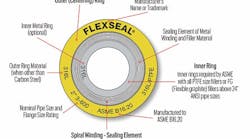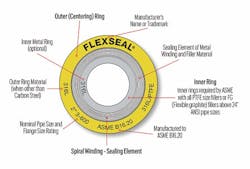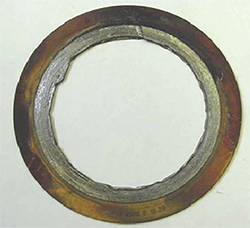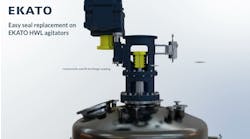Maintenance: Avoid Gasket Surprises
The scenario is all too common: A mechanic in your plant must replace a gasket. So, the person goes to your storeroom and picks out a green one in the required size. It has no labeling or markings; it’s a popular one that’s been used before.
What just happened? Your plant has started down a path to failure as a consequence of again choosing a $2 replacement gasket without understanding what that gasket really is. Just because it’s been used before doesn’t mean it’s right. You’re merely repeating the first mistake until your luck runs out.
Many managers at plants don’t appreciate they have gasket issues. After all, gaskets often last a long time, maybe until the next turnaround. However, the right gasket and installation might provide a service life of five or ten years.
The number one job of a gasket is to seal. Some gasket materials seal better than others. Manufacturers actually publish their gasket material leak rates. All gasket materials leak; it may be in milliliters over years or over days. You get to choose how much.
Gaskets are very forgiving, some more than others. You just may have lucked out for a long time until a gasket gets pushed beyond its limits. Frequently, someone replaces an original gasket that satisfies certain specifications with a look-alike material; this substitution often occurs without the knowledge of people in operations.
It’s easy to take gasketing for granted — but doing so eventually will cost you. At worst, it could lead to millions of dollars in injuries, environmental issues and lost production time.
Buyer Beware
Copied, inferior gaskets are rampant in this global market. In the past, some of your local gasket fabricators and distributors relied on major manufacturers that 1) heavily invest in research and development (R&D), 2) have application engineers, 3) boast a proven history with their material, and 4) are proud to label their material for identification.
Now, sometimes to the end-user’s detriment, any gasket fabricator or supplier can order an imported container full of any color and style of gasket material. Unprincipled companies not only copy the material as cheaply as they can but also copy the technical information without doing any testing — often even making their published maximum ratings a little higher than the proven manufacturers’ numbers.
I personally have seen import gasket material that had sticks and bark visibly embedded during its manufacturing process and that smelled so bad it had to be put outside the building. My “favorite” copied gasket material is styrene-butadiene rubber, better known as red rubber. This, mostly cheap, imported lower-grade rubber/clay material, in many cases can suffice for low-temperature, non-potable water service. However, it’s inappropriate and even potentially dangerous to use red rubber on oil and chemical applications because of its inherent incompatibility.
The Real Cost
Think twice before using $2/ft2 red rubber gasket material instead of $10/ft2 premium rubber. You’re fooling yourself if you believe you’d be saving money. Purchase price doesn’t equal the real cost of ownership.
Let’s say your plant has 1,000 flange connections of a popular-sized gasket, e.g., a 2-in.-dia.150-lb ⅛-in.-thick non-asbestos ring. You can choose an $0.86 green fiber gasket made of low-grade material with a projected two-year life or a $9.84 off-white gasket made of proven, domestic higher-grade polytetrafluoroethylene (PTFE) with a projected life exceeding five years.
Let’s compare only two aspects — material and labor — of the total cost of ownership:
For the cheaper gasket, the purchase cost is $0.86 × 1,000 = $86.00.
Let’s assume each installation takes 30 minutes and costs $30. So, the labor cost amounts to $30 × 1,000 = $30,000.
Thus, the two together total $30,086.
However, after two years, the gaskets require replacement, costing another $30,086.
In four years, the plant will spend $60,172.
For the premium gasket, the purchase cost is $9.84 × 1,000 = $9,840.
Each installation also takes 30 minutes, so the overall labor cost is $30 × 1,000 = $30,000.
The two costs together add up to $39,840.
Opting for the better gasket that lasts much longer than two years actually saves you $20,332.
Moreover, we haven’t considered additional potential costs such as those resulting from complete failure (safety, environmental and lost production) and from daily accepted leakage (health, leak detection and repair, fines, corrosion of equipment assets, and environmental issues). The premium gasket will incur significantly lower costs here, too. Indeed, it may prevent accidents and spills that could cost millions.
Now, considering there are about two dozen common sizes of ½-in.–24-in. ANSI standard pipe flange gaskets, you can see the scope of potential savings.
Don’t fall for a false economy and compromise safety and performance by using cheaper, copied, “me too” or low-grade gaskets.
Figure 1. Suitable for harsher service conditions, this gasket consists of a number of elements. Source. Garlock Sealing Technologies.
Metal Spiral Wound Gaskets
When a rubber, fiber or PTFE gasket won’t suffice, such as when a service involves extreme temperatures and harsh chemicals, plants typically choose a metal spiral wound gasket (Figure 1). This 100-year-old design is the most commonly used option in the gasket market. After all, it’s made of metal so it’s “strong” (which gives the user a good, safe feeling), seals well and is cheap. However, here, too, thinking all gaskets are the same will cost you.
Spiral wound gaskets in standard ANSI ½-in.–24-in. sizes are used in large volume. They are imported in container loads by domestic metal gasket manufacturers. Even local gasket fabricators/suppliers can order spiral wound gaskets directly from abroad and have them delivered by container to their front door. Many of these gaskets are produced in the same plants overseas to the same standards; the name is labeled per customer requirements. Many of these manufacturers can make these standard sizes in the U.S. but not at the same cost.
Figure 2. Standard spiral wound gaskets may not suffice for many services.
The refining industry now views basic spiral wound gaskets far differently than most manufacturing sectors. Concerns about safety, emissions, fire and explosions have prompted refiners to take the lead in adopting the latest metal gasket sealing technology. You won’t find a basic spiral wound gasket in these progressive users’ critical services because they don’t want to risk failure (Figure 2).
If you use a basic spiral wound gasket (for example, a 2-in. 300-lb. Type-304 stainless steel and glass-fiber-filled, $1.75/gasket) and expect safety and performance, keep in mind the following known spiral wound gasket issues:
• The spiral wound sealing elements are fragile to ship and handle. Especially on larger sizes, they easily can be damaged, causing waste.
• The spiral wound sealing element can come loose and get in the piping system. The next time you clean out a strainer and find a metal spider web in it, know you’re missing the guts out of a basic leaking spiral wound gasket somewhere.
• Proven leakage rates are high.
• Spiral wound gaskets don’t do well in retaining bolt load, which is the number one issue in maintaining a good seal.
• Inattention to color-coding can lead to misapplication.
• Inconsistencies in controlled density manufacturing of the spiral wound sealing element can prevent uniform loading and a proper seal.
• The sealing element on PTFE-filled spiral wound gaskets is susceptible to cold flow that can cause leaking; the American Society of Mechanical Engineers now recommends adding an extra inner ring to stop this leaking.
Fortunately, many new styles of gaskets, gasketing materials and metal gaskets can enhance sealing performance.
Assess Quality
Here are nine ways to potentially distinguish proven manufacturers from others and to help you choose a genuine product:
1. Brand and style labeling. Confirm the gasket material is labeled with brand and style. Even cut gaskets should have some markings. Non-labeled material can allow for inferior substitutions. Note, though, that some made-to-order “me too” materials have labels. The manufacturer may perform the bare minimum quality control and inspection and no actual testing. (This issue doesn’t just afflict gasketing but all types of industrial and consumer products.)
2. Continuous operating maximums. Proven manufacturers set temperature and pressure ratings for continuous operation. Other makers state maximum ratings based on intermittent/temporary conditions at best. Plants need to know the everyday limits of their gaskets.
3. Extreme flexibility. This may indicate a non-proven “me too” fiber gasket material that contains more-flexible filler materials like latex to cut cost. Cheaper fillers reduce the service capabilities by burning out at low temperatures or corroding away material not compatible with the medium, which decreases the volume of material in a given thickness, allowing the relaxing of bolting.
4. Manufacturing date codes. Such codes stamped on the material enable you to determine its age and track the batch and production for quality. Gasket material has a shelf life. The date code lets you know how long the material has been in storage (at the manufacturer, supplier and in your own stockroom), so you can tell how much life is left in the new product before you install it. Be wary of any product (and manufacturer) that doesn’t stamp a date code.
5. Extreme cost differences. Treat dramatic differences in price between “comparable” gasketing as a red flag. The “bargain” product may be cheap because of low offshore labor cost and low-grade raw material substitutions.
6. Know for sure what gasket you are choosing from your inventory. Color and feel alone aren’t enough. As already noted, using the same gasket as last time may just continue the first mistake, with which you may have been (luckily) getting by. Gaskets are the weak link in flanged piping systems. Fortunately, gaskets generally are forgiving — so even the wrong gasket may last for some time because of the small cross-section of material that actually contacts the process medium. However, heat and pressure increase the sealing failure rate.
7. Use the plant’s gasketing specifications standards. While these are proven, they generally need updating. Contact a gasketing specialist to get options on updating.
8. Question and verify “me too” substitution. Did an application engineer confirm the replacement truly is equivalent? Has it been tested at your location? Was the total cost of ownership considered? Do you have documentation for these points? If not, you’re failing your safety responsibilities.
9. Check the color coding on spiral wound gaskets. Industrywide, they all are color-coded and stamped for identification. Keep in mind that spiral wound gaskets with sealing element color-coded with a pink stripe are for low-temperature, very general service. However, because they often are stored in the same location and bin as critical service gaskets, they can find their way into critical gasket services like high-pressure steam.
Take Steps Now
You should do three things without delay:
1. Look at your inventory. In a large majority of storerooms surveyed, spiral wound gaskets and same-sized gaskets with mixed service color codes were on the same shelf, often stacked on top of each other or jumbled together. This raises the potential for use of the wrong gaskets in critical applications. So, ensure you separate industry standard, different color-coded spiral wound gaskets. Consider upgrading to a newer-style metal gasket for better sealing.
2. Use proven manufacturers. Opt for products from long-established makers that invest in R&D, can supply case histories, and have applications engineering staff to help you. Look for manufacturers with customer field representation that work with a proven distributor/supplier with training and experience.
3. Request the help of a qualified gasket specialist, and skill-up on proper gasket selection and usage. Many styles of gaskets used today are based on 100-year-old designs. However, the field isn’t static and your plant gasketing specifications likely need updating and consolidating. Hard documentation shows that you may achieve substantial cost savings even when using a more-expensive type of gasket material. Proper gasket selection procedures and installation classes are available.
You want your gaskets to seal, so buy your gaskets on sealing performance, not price. Don’t accept inferior copies! Your employees, customers and your bottom line will thank you.
JEFF ARNOLD is Mobile, Ala.-based director of sealing solutions for the Conveyance Solutions Group of Motion Industries. Email him at [email protected].




